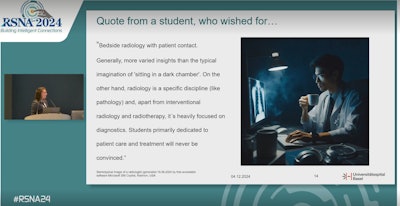CHICAGO -- Educational initiatives may be needed to address misconceptions about radiology among medical students and highlight the field’s attractiveness as a career for graduates, a study presented December 4 at RSNA 2024 found.
In her presentation, Magdalena Seng, MD, from University Hospital Basel in Switzerland showed survey findings indicating that while medical students recognize radiology’s importance, many are not interested in pursuing a career as radiologists.
“Many students express a desire for more exposure to hands-on radiology in the medical curriculum and seek opportunities for more patient contact,” Seng said.
Radiologists continue to experience rising imaging volumes. However, the number of radiologists has remained stagnant as the field struggles with workforce challenges. These developments have led to some researchers looking into how to make the field more attractive for medical students.
“We all have to face this problem,” Seng said. “We have to ask ourselves why radiology is less appealing to future doctors.”
The Seng team assessed the attitudes of medical students toward radiology, their perceptions of university curricula, the clinical relevance of the field, and reasons for seeking or avoiding a career in radiology.
 Magdalena Seng, MD, presents survey findings at RSNA 2024 showing the attitudes and perceptions of medical students when it comes to careers in radiology.
Magdalena Seng, MD, presents survey findings at RSNA 2024 showing the attitudes and perceptions of medical students when it comes to careers in radiology.
The researchers distributed an 18-question survey to 21 universities in Germany, Switzerland, and Austria. Within one month, the team collected complete survey data from 1,184 medical students, of whom 753 were female.
The researchers found the following:
Seng added that respondents listed the following measures and initiatives that could make radiology more attractive: lack of patient contact (while many cited this as a reason to not pursue a radiology career, others listed it as an attractive feature), hands-on teaching of appropriate modality use, and interdisciplinary teamwork.
“Students picture us working in a dark room reviewing x-rays. They believe there’s a lot of money, but no patient contact at all,” Seng said.
She called for the creation of a more engaging curriculum that reflects contemporary radiology practices to generate greater interest and prevent workforce shortages.
For full coverage of RSNA 2024, visit our RADCast.

Whether you are a professional looking for a new job or a representative of an organization who needs workforce solutions - we are here to help.